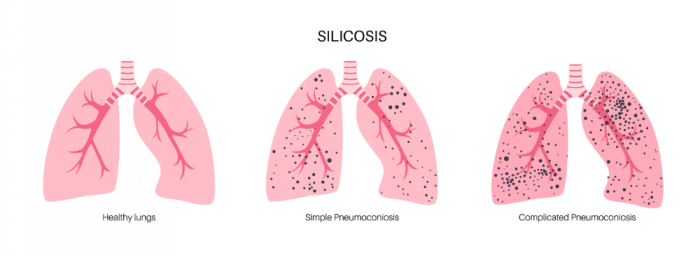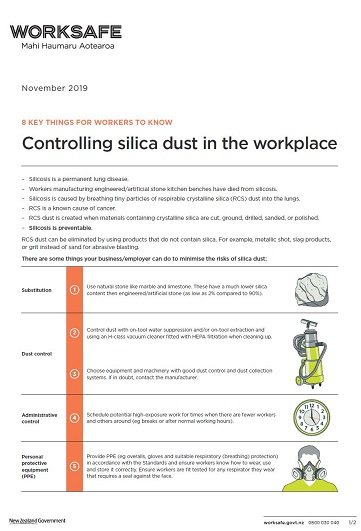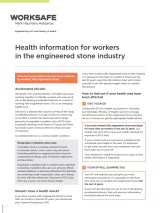Wishing everyone a safe and happy Christmas and New Year – Meri Kirihimete from the Healthify team.
Silicosis
Key points about silicosis
- Silicosis is an irreversible chronic lung disease caused by breathing in too much crystalline silica dust found in some types of stone, rock, clay and sand.
- There are different types – chronic, accelerated and acute.
- Common symptoms include persistent cough, shortness of breath and tiredness.
- Symptoms develop over time and at different rates depending on the type of silicosis.
- Talk to your healthcare provider and employer if you work with silica and are concerned.

What is silicosis?
Silicosis is a type of lung disease caused by breathing in too much crystalline silica dust. Silica is found in some types of stone, rock, sand and clay. If you work with these materials, you can easily breathe it into your lungs. Very fine silica dust scars your lungs and results in loss of lung function.
Common symptoms are ongoing cough, shortness of breath and tiredness. Silicosis is irreversible (can't be cured) but treatment can help relieve symptoms.
There are 3 different types of silicosis – accelerated, acute and chronic. Symptoms develop and worsen over 3 to 10 years with the accelerated type, more quickly with the acute type and more slowly with the chronic type.
Silicosis is a preventable disease. WorkSafe New Zealand has clear guidance for all potential employers. If you work with materials containing silica you should wear protection to avoid breathing in the dust and getting silicosis. If you have concerns, talk to your healthcare provider and your employer.
Where might I be exposed to silica?
You're at risk of getting silicosis if you work in the following industries:
- engineered stone benchtops (these benchtops have 90% silica – more than natural stone)
- stone masonry and stone cutting
- mining and quarrying
- construction and demolition, especially crushing or polishing cement
- pottery, ceramics and glass manufacturing
- sandblasting.
When should I see a healthcare provider?
- persistent cough
- persistent shortness of breath
- tiredness, fatigue and reduced exercise tolerance.
Silica is found in some types of stone, rock, sand and clay. People who work with these materials can inhale easily the very fine silica dust into their lungs. Once the fine silica dust is inhaled, your body's immune system attacks it and causes inflammation, swelling and eventually scarring in your lungs.
Scar tissue (fibrosis) forms over time and this results in the loss of normal functioning lung tissue. It makes your lungs stiff and not work properly.

Image credit: Depositphotos
There are 3 types of silicosis:
- Chronic or nodular silicosis – this is the most common type. The symptoms of silicosis develop slowly and progressively over decades with prolonged silica exposure.
- Acute silicosis – the symptoms of silicosis develop quickly from a few weeks to less than 1 to 3 years after very high levels of exposure to silica.
- Accelerated silicosis – the symptoms of silicosis develop more quickly than in chronic silicosis – within 1 year, but less than 10 years after exposure to a large amount of silica in a short period of time. Accelerated silicosis is especially common in people who work with engineered stone benchtops.
Prolonged dust exposure can also result in chronic obstructive pulmonary disease (COPD) and may increase your risk of lung cancer.
The symptoms of silicosis usually develop slowly and progressively over years. If you're exposed to a large amount of silica dust in a short period of time, eg, in accelerated silicosis or acute silicosis, symptoms can develop more rapidly.
Common symptoms of silicosis include:
- persistent cough
- persistent shortness of breath
- tiredness, fatigue and reduced exercise tolerance
- loss of appetite and weight loss (late symptoms).
As these symptoms tend to develop slowly, you may not notice them until after you've stopped working with silica dust. Symptoms can also get worse even if you're no longer working in the industry and not still being exposed to silica dust.
In the most severe cases, the scarring of your lungs will result in low oxygen levels (hypoxia) which can put pressure on your heart (pulmonary hypertension) and cause heart failure.
Your healthcare provider will ask you questions about your symptoms, including your occupation and how long you've been exposed to silica dust. Your healthcare provider will also listen to and examine your lungs. Tests that may be done include:
- chest X-ray
- lung function tests, eg, a spirometry and additional more extensive testing
- CT scan of your lungs.
If you have silicosis, you should be referred to a lung specialist for follow-up.
There is no cure for silicosis so preventing it is extremely important.
Treatments aim to relieve your symptoms and check your progression. If you're still exposed to silica dust, your healthcare provider or lung specialist doctor will advise you to stop any further exposure. Lung transplantation is the ultimate treatment for the most severe forms of silicosis.
If you have silicosis, your lungs are already damaged. There are self-care measures to protect your lungs from further damage. Here are some examples:
- Stop further exposure to silica dust even if that means you have to stop working (you may be eligible for a benefit)
- Stop smoking if applicable, also stop vaping
- Have annual flu vaccinations, COVID-19 boosters, the 10-yearly whooping cough (+tetanus) booster, the pneumococcal vaccination and the RSV vaccination although the last 2 vaccinations aren't funded.
- Stay active at a level you can manage, aim for 20 to 30 minutes per day. "Huffing and puffing” is okay and won't cause damage as long as you remain in control – a physiotherapist can advise on the right exercises for you
- See your healthcare provider quickly if you have any signs of chest infection so you can be treated. Signs include a fever (high temperature), shortness of breath, chest pain or cough.
Apps reviewed by Healthify
You may find it useful to look at some breathing apps.
Having enough protection from silica dust is the best way to prevent silicosis. Employers in any industry involved in working with silica should have reviewed their business and completed a risk assessment for silica exposure for their workers. Read more about the silica dust in the workplace(external link) guide for employers.
WorkSafe New Zealand, the Ministry of Health and ACC have worked together on a health assessment process.
Generally, things that you can do as an employee if you're exposed to silica dust in your workplace include:
- wearing and using personal protective equipment (PPE) correctly – talk to your employer if you need training on how to use a PPE in a correct way
- not bringing dust-covered work clothes home – leave them at your workplace to be cleaned
- washing your hands before eating, drinking, smoking and leaving work at the end of the day.
Read more about the key things workers need to know about controlling silica dust in the workplace(external link).
Talk to your healthcare provider about making an ACC(external link) claim. Work and Income NZ(external link) may help you in finding options and benefits if you have to stop work. Worksafe NZ(external link) is a New Zealand primary work safety and health regulator. Part of their role is to ensure that businesses and workers meet their responsibilities in minimising the risk of developing silicosis.
If you need to talk to someone, talk to your healthcare provider to find a counsellor. Alternatively, you can call 1737(external link) or Lifeline Aotearoa(external link) 0800 543 354 for free counselling or look for a counsellor by entering your address into the Healthpoint search page(external link).
Silica dust in the workplace(external link) WorkSafe, NZ
Accelerated silicosis(external link) WorkSafe, NZ
Silicosis(external link) NHS, UK
Brochures
Health information for workers in the engineered stone industry(external link) WorkSafe, NZ – PDFs can be downloaded in English, te reo Māori, Samoan, Chinese simplified, Chinese traditional, Hindi, Portuguese
Silica dust in the workplace for employers or persons conducting business [PDF, 142 KB] Worksafe, NZ Chinese Simplified and English [PDF, 634 KB], Chinese Traditional and English [PDF, 657 KB], Hindi and English [PDF, 623 KB], Samoan and English [PDF, 509 KB], Tagalog and English [PDF, 509 KB], te reo Māori and English [PDF, 509 KB], Tongan and English [PDF, 510 KB]
8 key things for workers to know – controlling silica dust in the workplace [PDF, 89 KB] Worksafe, NZ Chinese Simplified and English [PDF, 519 KB], Chinese Traditional and English [PDF, 530 KB], Hindi and English [PDF, 523 KB], Samoan and English [PDF, 463 KB], Tagalog and English [PDF, 462 KB], te reo Māori and English [PDF, 463 KB], Tongan and English [PDF, 464 KB]
Apps
References
- Silica exposure(external link) Canterbury Regional HealthPathways, NZ, 2024
- Accelerated silicosis overview(external link) The Royal Australasian College of Physicians, 2020
- Accelerated silicosis assessment pathway(external link) Health New Zealand | Te Whatu Ora
- National guidance for doctors assessing workers exposed to respirable crystalline silica dust(external link) Australian Government Department of Health and Aged Care, 2022
Accelerated silicosis(external link) Health New Zealand | Te Whatu Ora 2024
Accelerated silicosis assessment pathway guidance(external link) Health New Zealand | Te Whatu Ora, 2024
Accelerated silicosis overview(external link) The Royal Australasian College of Physicians, 2024
Accelerated silicosis(external link) ACC, NZ, 2024
Brochures

Worksafe, NZ, 2019
English, Chinese Simplified and English, Chinese Traditional and English, Hindi and English, Samoan and English, Tagalog and English, te reo Māori and English, Tongan and English
Credits: Healthify editorial team. Healthify is brought to you by Health Navigator Charitable Trust.
Reviewed by: Dr Roland Meyer, Specialist Physician, Respiratory and General Medicine
Last reviewed:






